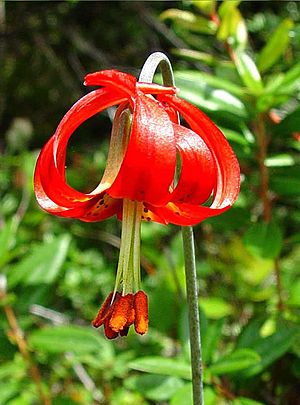Western lily facts for kids
Quick facts for kids Western lily |
|
|---|---|
 |
|
| Conservation status | |
| Scientific classification | |
| Kingdom: | |
| (unranked): | |
| (unranked): | |
| Order: | |
| Family: | |
| Genus: | |
| Species: |
L. occidentale
|
| Binomial name | |
| Lilium occidentale Purdy
|
|
The Lilium occidentale is a beautiful and rare flower from North America. It's often called the western lily because its name 'Occidentale' means 'westernmost'. This special lily grows only in a small area along the coast of northwestern California and southwestern Oregon. It likes to live in wet places like coastal prairies, swamps, and even sandy cliffs near the ocean.
This amazing wildflower is very rare. It is officially listed as an endangered species by the government. This means it needs special protection to survive.
Contents
Where the Western Lily Lives
The western lily is found along a narrow strip of coast, about 200 miles long. This area stretches from Florence, Oregon, down to Eureka, California. It usually grows close enough to the ocean that you can see it!
What the Western Lily Looks Like
The western lily is a tall plant that can grow over two meters (about 6.5 feet) high. It grows from a large, scaly bulb that can be almost 10 centimeters (4 inches) long.
Leaves and Flowers
Its leaves grow in circles around the stem. They can be long and thin or more oval-shaped, sometimes over 20 centimeters (8 inches) long. The plant can have up to 35 beautiful, nodding lily flowers. Each flower has six petals, called tepals, which can be up to 8 centimeters (3 inches) long. These tepals often curl back into full rings.
The flowers are usually red, orange, or yellow-green. They often have two colors, with more red on the inside and greenish-yellow on the outside. You might also see spots on them! Inside the flower, there are six long parts called stamens, which have large red tips. There's also a long central part called a pistil.
How it Gets Pollinated
The western lily is mostly pollinated by hummingbirds. One of the main helpers is Allen's hummingbird (Selasphorus sasin). These tiny birds love the nectar from the lily's colorful flowers.
Why the Western Lily is in Danger
Many things threaten the western lily and make it hard for it to survive.
Main Threats
- Animals and People: Things like grazing animals (like cows) walking on the plants can hurt them.
- Building and Farming: When people build homes or farms, especially cranberry farms, it can destroy the lily's habitat.
- Roads and Vehicles: Road work and cars can also damage the plants.
- Collecting: Some people illegally collect the bulbs and flowers, which harms the wild population.
Habitat Changes
Trees growing into the lily's habitat can change the water and soil, making it hard for the lily to grow. Also, stopping natural wildfires can sometimes hurt the lily, as fires can help clear space for it.
In 1994, when the western lily was first listed as endangered, there were only about 2,000 to 3,000 plants left.
Growing Western Lilies
Western lilies can be grown from seeds if they are kept in cold conditions first. They can also grow well in special wet areas that are like bogs, as long as they get enough moisture.
Sometimes, the western lily can mix with other native lilies, like L. columbianum, when they grow close together. This can make it tricky to tell the "true" western lily apart from its mixed relatives.
Protecting the Western Lily
Because the western lily is a federally protected species, it is against the law to own or sell any part of the plant (like seeds, bulbs, or leaves) without special permission. This protection helps keep this rare and beautiful flower safe for the future.
Toxicity
Cats
It's very important to know that lilies are extremely dangerous for cats. If a cat eats any part of a lily, it can be deadly. If you have cats, it's best not to have this plant in your home or garden. Even pollen from dried flowers can be harmful if a cat gets it on their fur and then licks it off.
If you think a cat has eaten a lily, it needs to see a vet right away! Quick treatment can help reduce the amount of poison absorbed. Vets might give the cat special charcoal or fluids to help them recover.
See also
 In Spanish: Lilium occidentale para niños
In Spanish: Lilium occidentale para niños


